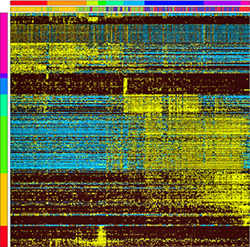Genetic Tug of War Before Cells Decide Fate

Complete the form below to unlock access to ALL audio articles.

Developing blood cells are caught in tugs of war between competing gene regulatory networks before finally deciding what type of cell to become, according to a study published in Nature.
Researchers at Cincinnati Children’s Hospital Medical Center report that as developing blood cells are triggered by a multitude of genetic signals firing on and off, they are pulled back and forth in fluctuating multi-lineage states before finally becoming specific cell types. Although the scientists still don’t understand exactly what decides the cells eventual fate, their work suggests that competing gene networks induce dynamic instability, resulting in mixed-lineage states that are necessary to prime newly forming cells for that decision.
It is somewhat chaotic but from that chaos results order. It’s a basic finding that helps us address a fundamental question of developmental biology – what are the nature of the intermediate states and the networks of regulatory genes that underlie cell-type specification,” said Harinder Singh, PhD, study co-author and Director of Immunobiology and the Center for Systems Immunology at Cincinnati Children’s.
Although the findings require extensive additional study to better understand the back-and-forth nature of this genetic process, the research may eventually provide new insights into developmental miscues that cause disease, according to H. Leighton Grimes, PhD, study co-author and Investigator in the Divisions of Immunobiology and Experimental Hematology and Cancer Biology at Cincinnati Children’s.
“How do blood cells know to become neutrophils or monocytes?” Grimes asked. “Two thirds of your bone marrow is taken up with this activity and the number of cells has to be exquisitely balanced. Too many or too few of either can kill you.”
In the current study the research team looked specifically at the formation of neutrophil and monocyte (macrophage) blood cells – critical components of the immune system. The researchers studied mouse cells as they developed in a natural state using a new and rapidly expanding technology called single-cell RNA sequencing – which identifies the genetic expression programs of individual cells and their presumptive regulators.
Big Data Biology
The authors blended laboratory biology with a new bioinformatics computer program (ICGS) developed at Cincinnati Children’s with study co-author Nathan Salomonis, PhD, Division of Biomedical Informatics. ICGS (Iterative Clustering and Guide-Gene Selection) gives researchers a comprehensive view of the overwhelming amount of data generated by single-cell RNA sequencing.
ICGS takes the additional step of giving researchers an intuitive platform that can process and analyze all of the sequencing and biological data to identify the various transitioning or shifting genomic and cellular states of cells – in this instance developing blood cells.
Dynamic Instability
Prior to the current study it already had been proposed that neutrophil and macrophage blood cells result from a bi-stable gene regulatory network (one that can manifest either of two stable states). But the different cellular transition states and underlying molecular dynamics of development have remained unknown.
Repeatedly working back and forth between laboratory biology and computational analysis, authors of the current paper say their analysis of developing blood cells captured a prevalent mixed-lineage intermediate. These intermediates expressed a combination of genes including those typical of stem cells that can give rise to all blood cell types as well as some genes that are specific for red blood cells, platelets, macrophages and neutrophils. This seemed to reflect competing genetic programs.
The research team also found the developing cells moving through a rare state where they encountered turbulence termed “dynamic instability.” This was seen to be caused by two counteracting myeloid gene regulatory networks. Two key components of the counteracting gene networks were Irf8 and Gfi1, genes that are involved in blood cell formation. Both genes encode transcription factors, which mean that their protein product controls what genetic information is used in the formation of a cell. When Irf8 and Gfi1 were eliminated from the picture, researchers showed that the rare cells could be trapped in an intermediate state.
As they continue their research, the authors want a clearer understanding of what finally causes cells in intermediate states of dynamic instability to assume specific fates. They suggest that the influence of two simultaneous and counteracting gene networks generates internal oscillations that are eventually stabilized by unknown mechanisms to generate one of two different cell fates.

